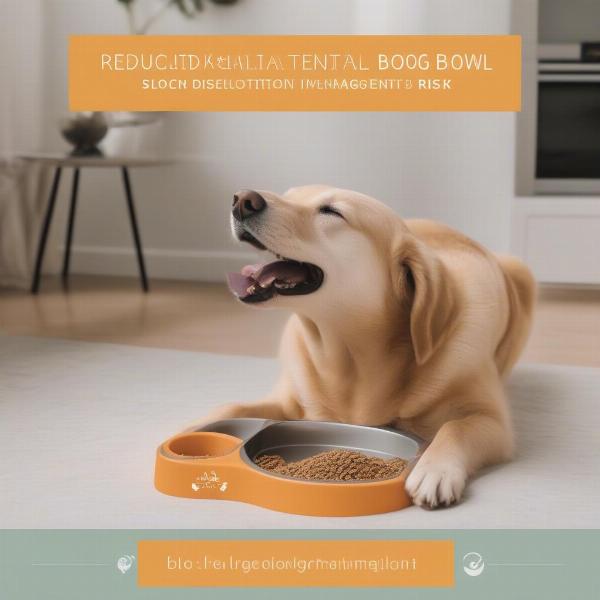Slow feeder dog bowls are a game-changer for dogs who inhale their food faster than a speeding bullet. These specially designed bowls help slow down mealtimes, preventing a whole host of digestive issues and promoting a healthier eating habit. Whether you’re dealing with a competitive eater, a dog prone to bloat, or simply want to make mealtimes more engaging, this guide will cover everything you need to know about dog bowl slow feeders.
Why Choose a Slow Feeder Dog Bowl?
There are several compelling reasons why a slow feeder bowl might be the perfect addition to your dog’s dining experience. For dogs who gulp down their food in seconds, these bowls are essential for preventing choking, vomiting, and regurgitation. By forcing your dog to eat more slowly, they can properly chew their food, leading to better digestion and nutrient absorption. Slow feeders can also help prevent bloat, a life-threatening condition that can occur when a dog’s stomach fills with gas and twists. Plus, the added challenge of navigating the obstacles in the bowl can provide mental stimulation and make mealtimes more engaging.
 Benefits of Slow Feeder Dog Bowls
Benefits of Slow Feeder Dog Bowls
Types of Slow Feeder Dog Bowls
Slow feeder bowls come in a wide variety of shapes, sizes, and materials to suit every dog and their unique needs. Some common types include:
- Maze Bowls: These bowls feature raised ridges and obstacles that create a maze-like pattern, forcing your dog to work for their food.
- Dish-shaped Bowls with Raised Sections: These bowls have strategically placed raised sections within a dish shape that slow down eating without being as challenging as a maze bowl.
- Slow Feeder Mats: These mats are designed for dogs who prefer to eat off the floor and can be easily rolled up for storage.
- Stainless Steel Slow Feeders: Durable and easy to clean, stainless steel options are a popular choice for many dog owners.
- Puzzle Feeders: These interactive feeders combine the benefits of a slow feeder with the mental stimulation of a puzzle.
Choosing the Right Slow Feeder for Your Dog
With so many options available, selecting the right slow feeder can feel overwhelming. Consider your dog’s breed, size, eating habits, and any specific health concerns when making your choice. large dog bowl slow feeder are specifically designed for larger breeds. For puppies or small dogs, opt for a bowl with smaller obstacles. If your dog is prone to allergies, stainless steel is a great hypoallergenic option. slow feeder stainless steel dog bowls are a popular choice.
How to Introduce a Slow Feeder Bowl
Introducing a slow feeder bowl should be a gradual process. Start by mixing a small amount of food in the slow feeder with the rest of their meal in their regular bowl. Gradually increase the proportion of food in the slow feeder over several days or weeks until your dog is comfortable eating exclusively from it.
Cleaning and Maintaining Your Slow Feeder Bowl
Just like regular dog bowls, slow feeders need to be cleaned regularly to prevent the growth of bacteria. Most slow feeders are dishwasher safe, but always check the manufacturer’s instructions. dog food dispenser for large dogs can also benefit from regular cleaning.
Are Slow Feeders Right for Every Dog?
While slow feeders are beneficial for many dogs, they aren’t a one-size-fits-all solution. Some dogs, particularly those with flat faces (brachycephalic breeds), may find it difficult to eat from certain types of slow feeders. Observe your dog’s behavior and adjust accordingly. big dogs menu offers some insight into feeding larger breeds, and you may also find dog dishes helpful.
Conclusion: A Healthier, Happier Mealtime with Slow Feeders
Investing in a dog bowl slow feeder can significantly improve your dog’s eating habits and overall well-being. By slowing down mealtimes, these bowls promote better digestion, prevent bloat, and provide mental stimulation. Choose the right slow feeder for your dog’s specific needs and introduce it gradually for a smooth transition.
FAQ:
- Do slow feeders work for all breeds? While generally beneficial, some breeds, like those with flat faces, may find certain types challenging.
- How do I clean a slow feeder bowl? Most are dishwasher safe, but always check the manufacturer’s instructions.
- What if my dog doesn’t like the slow feeder? Introduce it gradually and try different types to find one that suits your dog.
- Can puppies use slow feeders? Yes, choose one with smaller obstacles appropriate for their size.
- Are slow feeders only for fast eaters? No, they can also benefit dogs prone to bloat and provide mental stimulation.
- What material is best for a slow feeder? Stainless steel is a popular choice for its durability and hygiene.
- How do I choose the right size slow feeder? Consider your dog’s breed and size.
About ILM Dog: ILM Dog is your trusted source for all things dog care and wellbeing, offering expert advice on breed selection, health, training, nutrition, grooming, and much more. We aim to empower dog owners worldwide with the knowledge and resources to provide the best possible care for their furry companions. From choosing the right dog bowl to understanding your dog’s unique nutritional needs, ILM Dog is here to help. Contact us for expert advice: Email: [email protected], Phone: +44 20-3965-8624. Visit ILM Dog for more information.